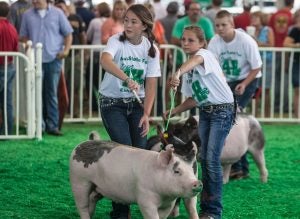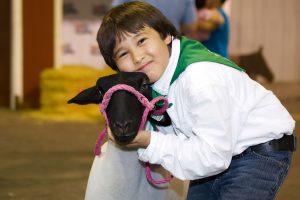Picture this: You sign your child up for a flag football league, and you’ve been practicing catch with them for weeks, teaching them how to kick, the rules, and how to run the ball. They’ve got their flag football belt, flags, mouth guard, and cleats, they step onto the field ready to play and receive the ball in an offensive catch. But, another player rips off their flags — the ball is dead.
Your kid cries, leaves the field, takes the football with them, and you go home. The coach calls and wants their football back — you refuse, your child is heartbroken, and after all — they shouldn’t have to give up a ball from their first game.
I use flag football as an example because it’s a game a 9-year-old can play. Conversely, nobody would expect a player to step onto the field in a tackle football game and then seek retribution after they’ve been tackled — after all, it’s part of the game.

Livestock showing is similar. When you choose to raise a market animal, the reality is that the end goal is to raise a quality meat product for the purpose of human consumption. And, if your livestock show and sale is a terminal one, the animal’s death is a part of the game — you don’t get to take them home.
Not long ago, I stumbled across the story of a 9-year-old girl in Shasta County, California, who didn’t want her market show goat to go to slaughter. My momma heart hurt for this girl. As I continued to read, though, I could feel frustration building for the divide we’ve allowed to wedge between showing junior market livestock, and the purpose these animals ultimately fulfill. And, for how ill-prepared this young lady was for her chosen activity: showing and selling a market animal.
As parents, adults, producers, and 4-H leaders, it’s our job to prepare our kids for any activity we put them in. And, it’s our job to listen to our children and to know when they’re just not ready to participate.
Death is also a part of life, and there are important lessons in learning that. Producers and youth exhibitors care for their animals well, and many of them care deeply. I don’t know very many ranchers or farmers who haven’t had a favorite cow or bull. And, it’s hard to say “goodbye” — I’ve certainly shed a tear over a few old cows that I’ve unloaded at the sale barn, or those that I helped process for own own table.
This year, I even held my own 9-year-old daughter while we both teared up over loading her first show calf, “Stewart,” onto the trailer. But, these animals had a clear purpose from the beginning, and it’s our job to understand that purpose, and to ensure that our kids do too.
After all, at the end of a terminal livestock project, it’s a source of pride to know that your buyers and consumers receive a quality, well-raised product that they can share with their family and friends.

It’s OK to be sad about selling your livestock, but it’s not OK to steal them.
While I can’t speak to the specifics of anything that transpired in the Shasta County case aside from what the Los Angeles Times and other news outlets have published, we’ve seen countless attempts by activists to “save” market livestock from their ultimate purpose over the years. And, that includes 4-H animals.
When this young lady entered into a contract with the fair board, and eventually with her buyer after the sale of her goat, “Cedar,” she likely made the commitment to complete her market project through a terminal sale. According to a news release, after the sale, this girl and her mother chose to remove the goat from the fairgrounds without permission from the goat’s new owner or the hosting fair board.
The sale of an animal results in the transfer of ownership, and while local articles published that this young lady’s buyer was amiable to other arrangements for her market goat, the fair board’s policy didn’t allow for anything but terminal processing of animals at the fair. Everyone should have been aware of this agreement from the get-go.
Local law enforcement got involved. The goat ultimately was seized with a warrant, the goat died, and we can gather based on what’s been published that this little girl got her heart broken. And, big surprise, attorneys and animal welfare groups are already involved.
»Related: Anti-FFA/4-H activist sparks debate among members
This young lady probably wasn’t ready to show a market livestock project. Many kids aren’t, and that’s OK too.
Showing market livestock allows our youth to take on a myriad of responsibility. But, it’s also a team sport. It’s a family affair.
From the very beginning, young producers are providing a high level of care for the animals they raise. They build personal relationships with them, but they also build life skills and participate in building their own small business through raising and selling livestock. They learn how to do this through accountability, modeling, and preparation from the adults in their lives.
Some families are equipped emotionally or otherwise to raise market livestock and prepare their kids for the “end game.” Some aren’t. And, if you’re not emotionally ready, please don’t take part.

There are other ways to be involved in agriculture.
There are other ways that youth can get involved in showing animals or in agriculture. A favorite of mine is the dog project. Many households have a family pet, and youth can learn to train, care for, and exhibit an animal that isn’t meant for consumption.
Even if your youth is set on showing livestock, horses are another option. While a significant financial and time investment, horses provide opportunities for youth to learn how to care for a type of non-terminal livestock. Dairy goats and some rabbit and poultry breeds may provide other venues as well.
At the end of the day, though, sickness and death are unavoidable — again, they’re part of life. And no matter what animal you choose to sell, learning how to properly care for them — even to the sometimes sad and uncomfortable end — is part of being involved in 4-H or FFA projects involving animals. If you’re not OK with that, there are plenty of other projects to pursue including indoor exhibits, technology, horticulture, and more.
Heidi Crnkovic, is the Associate Editor for AGDAILY. She is a New Mexico native with deep-seated roots in the Southwest and a passion for all things agriculture.



